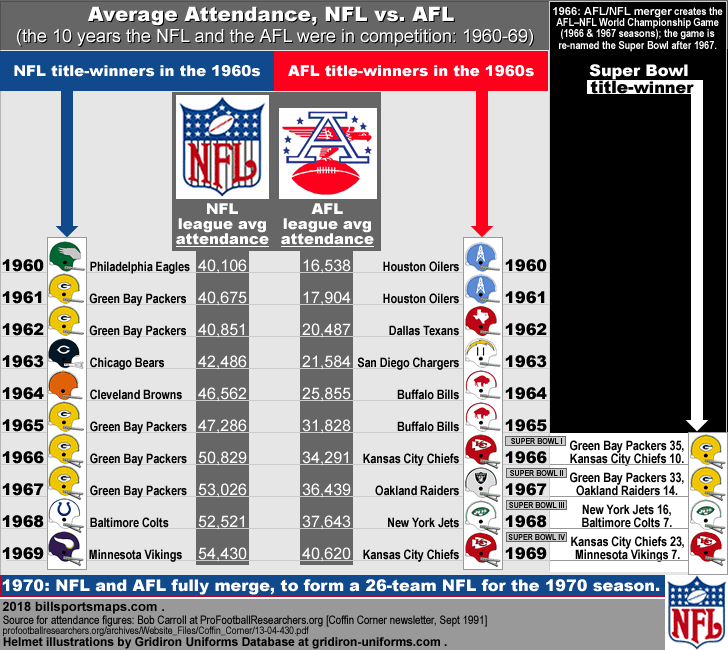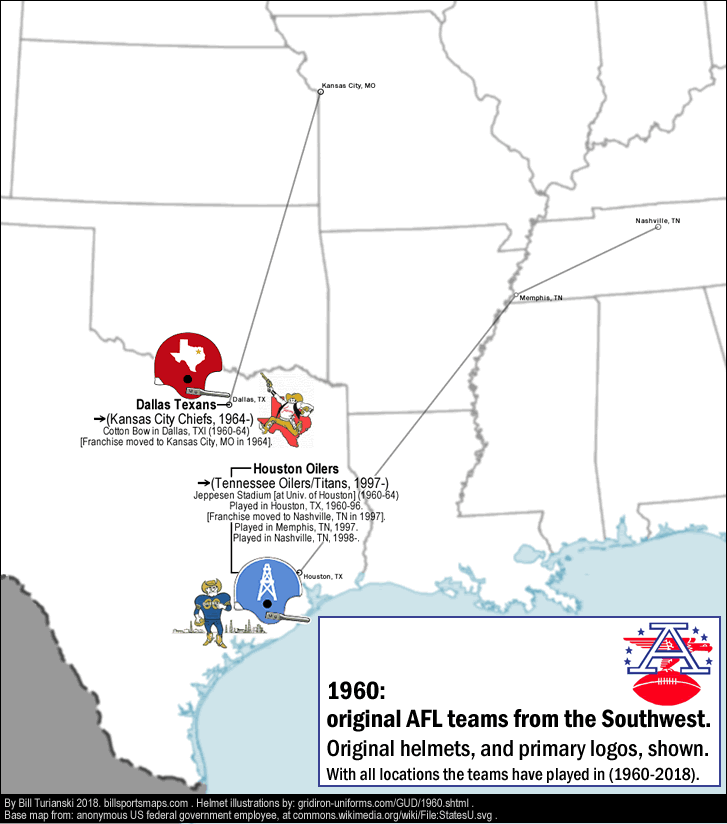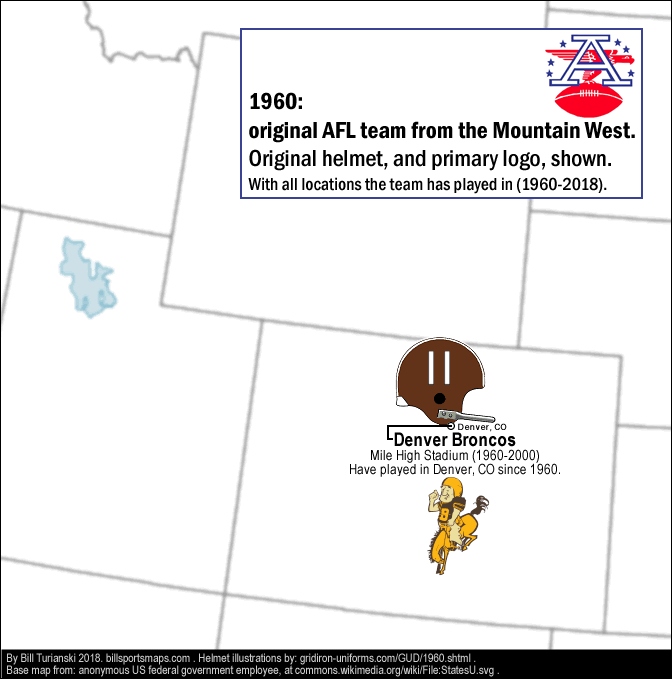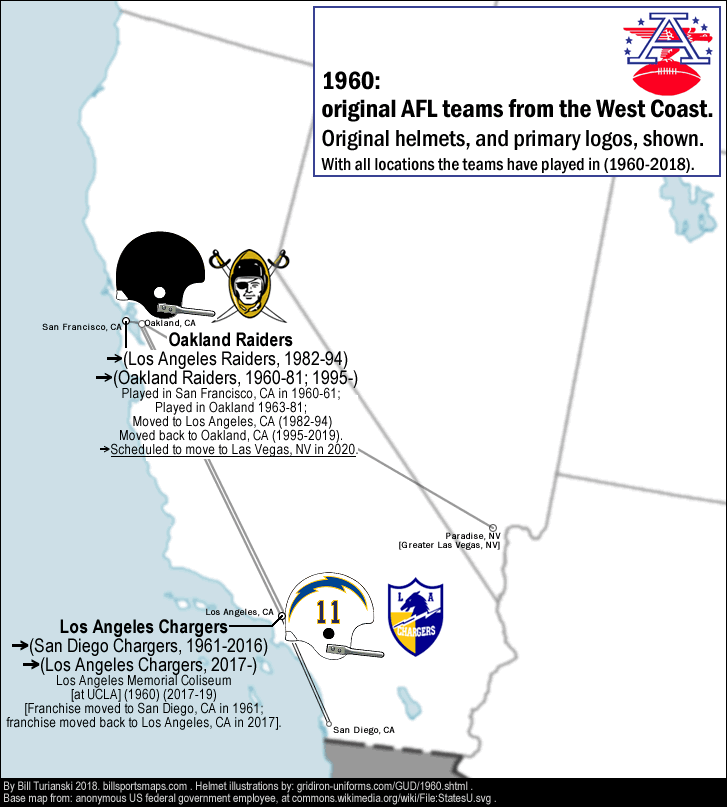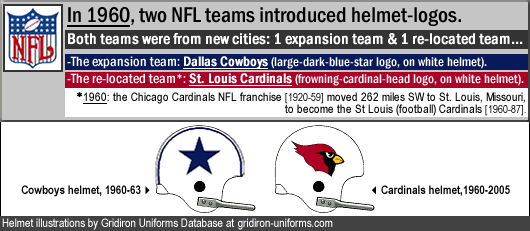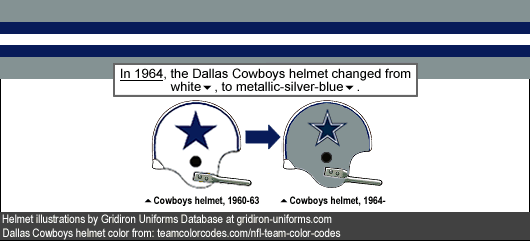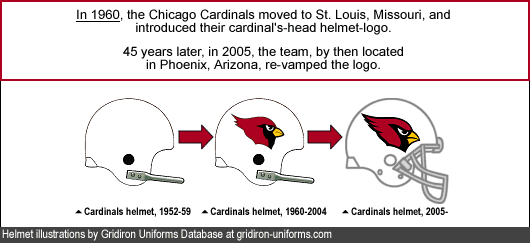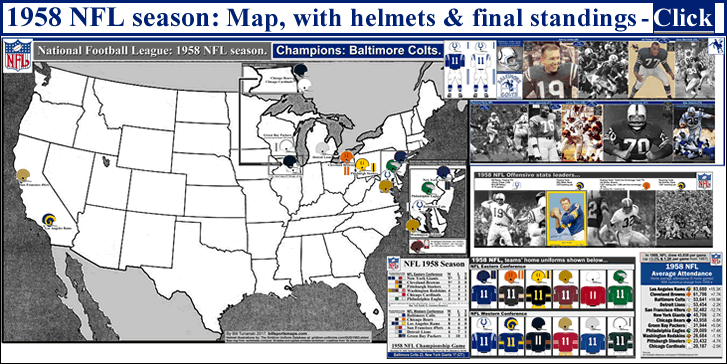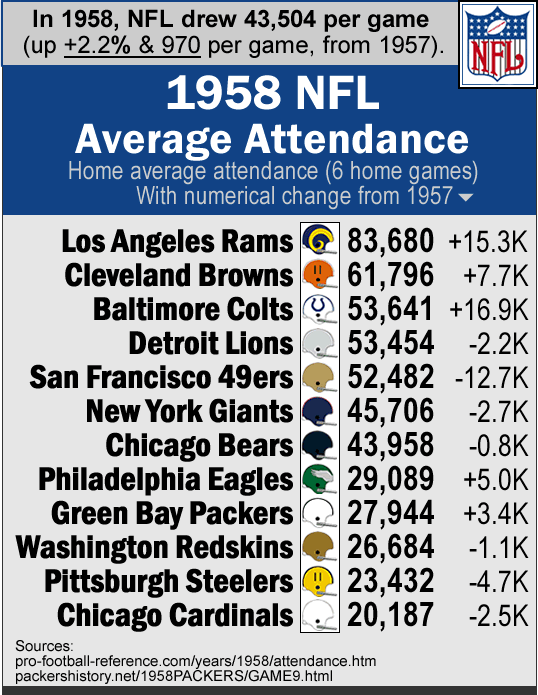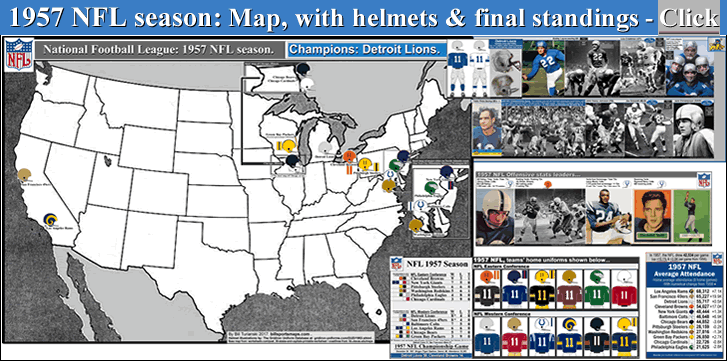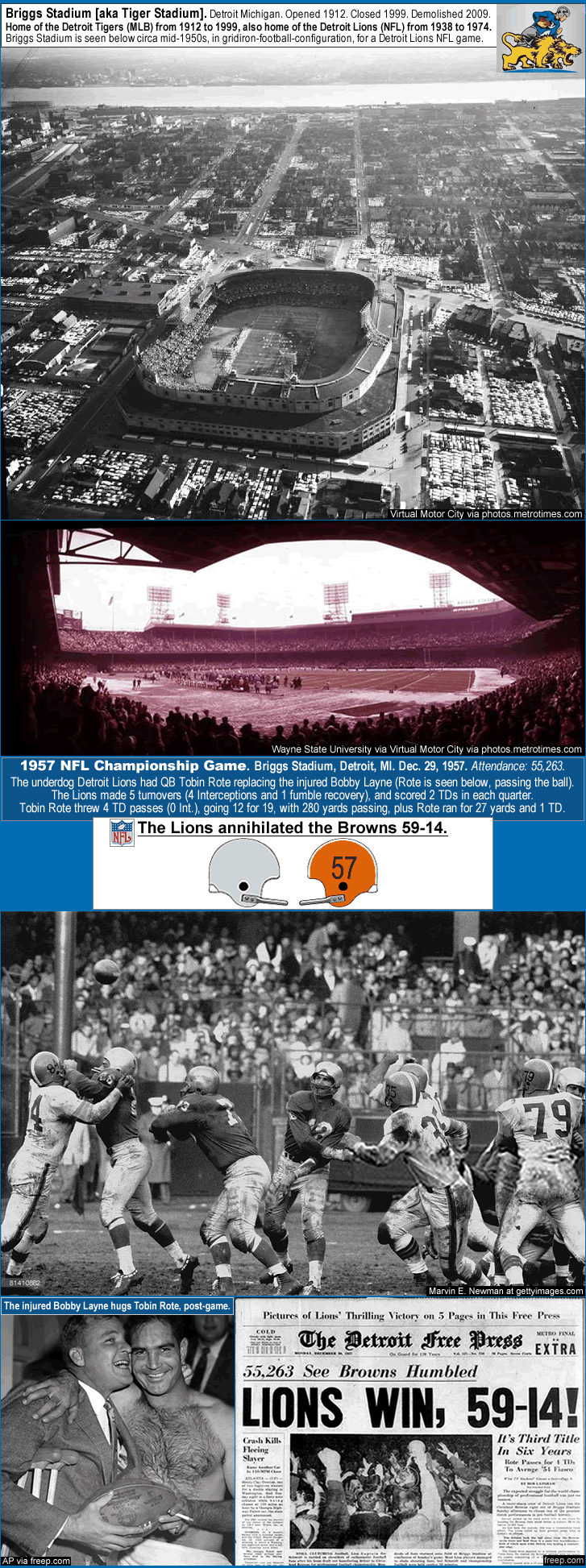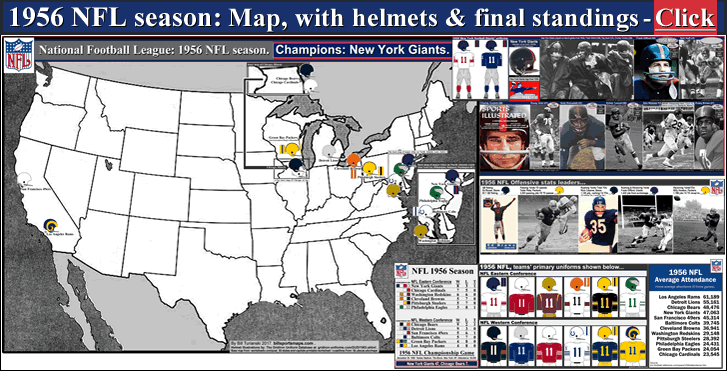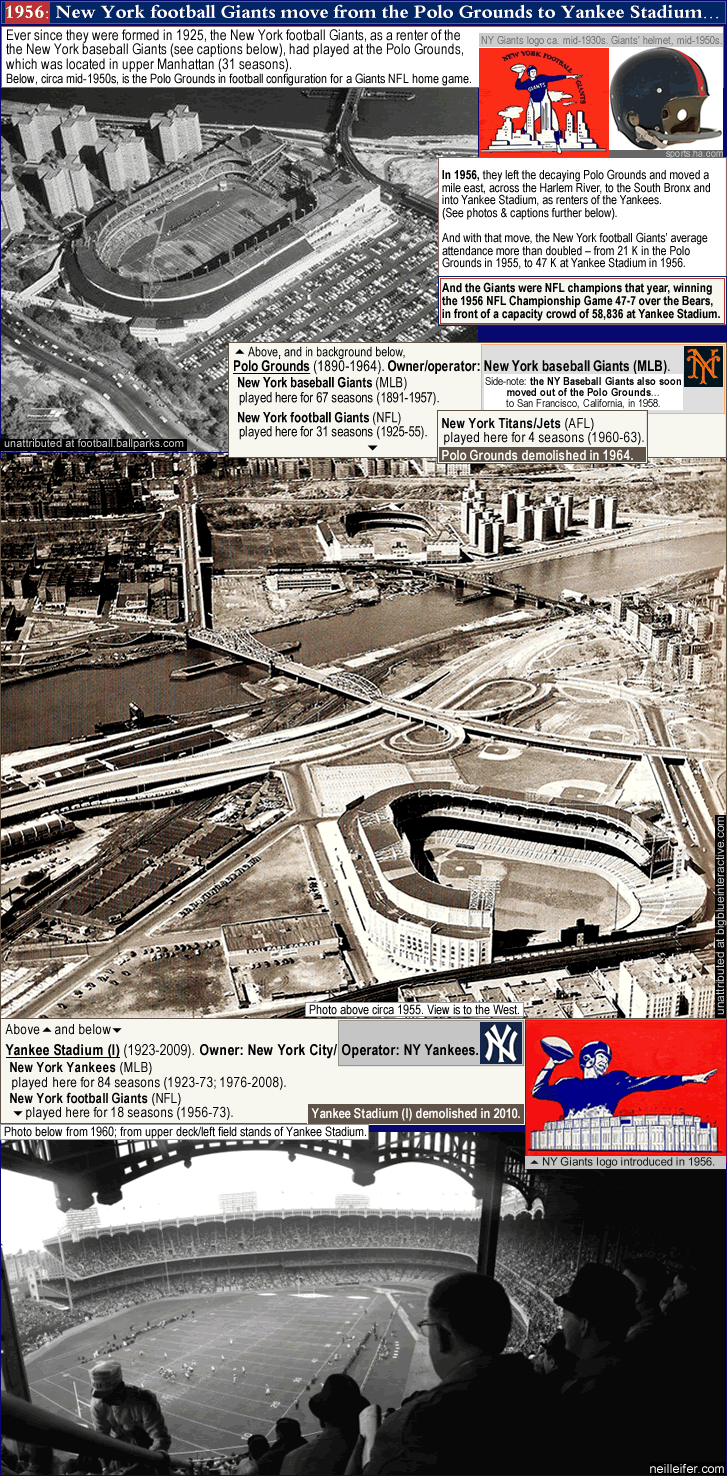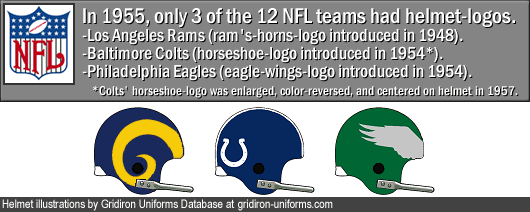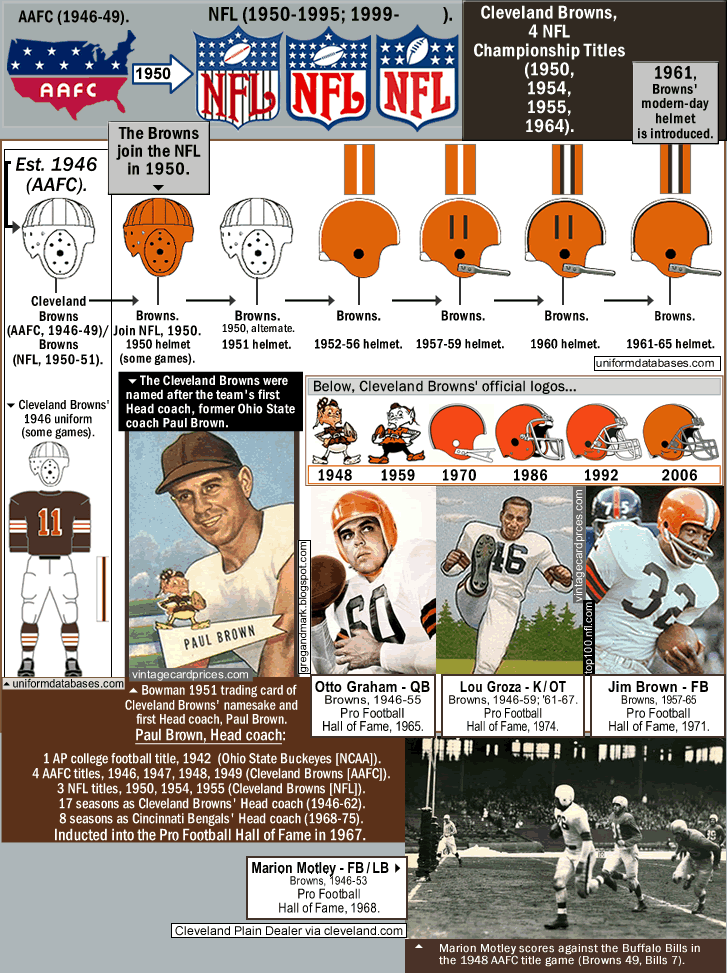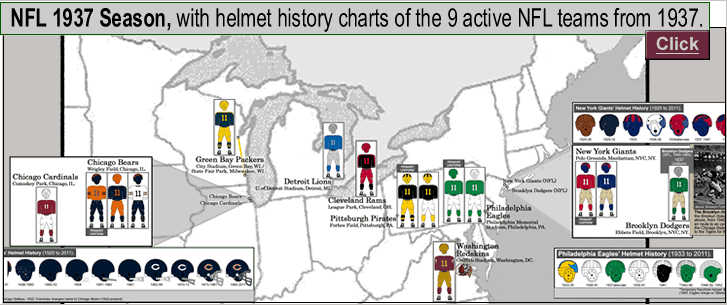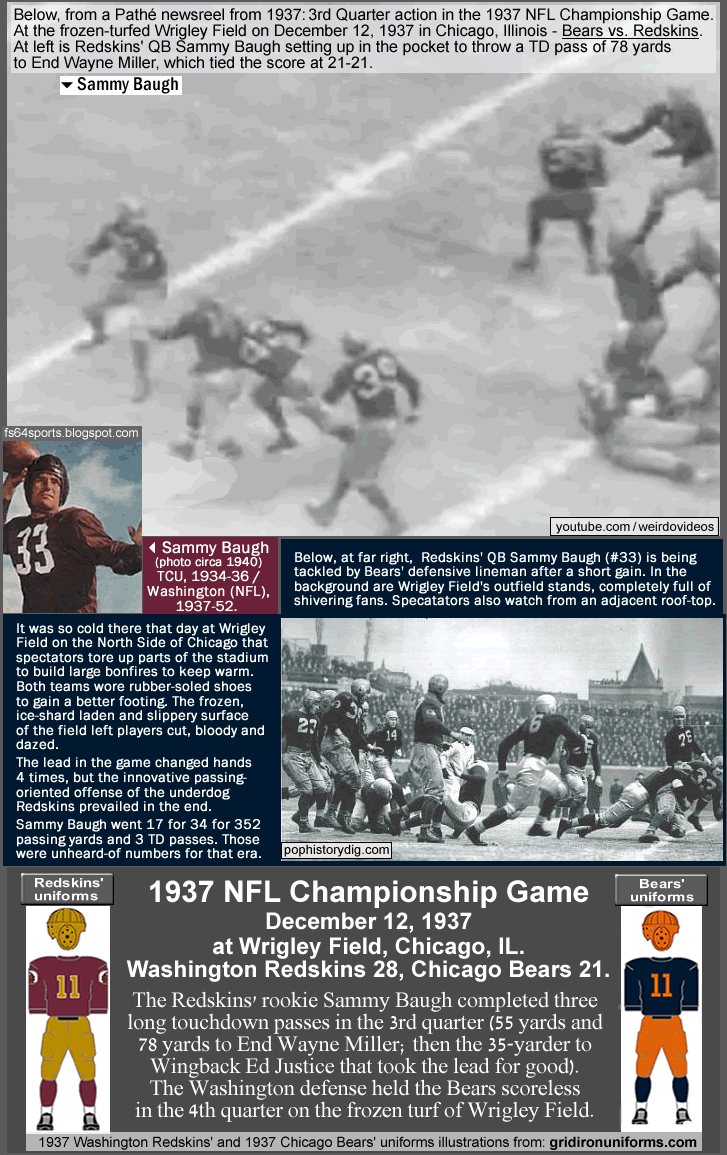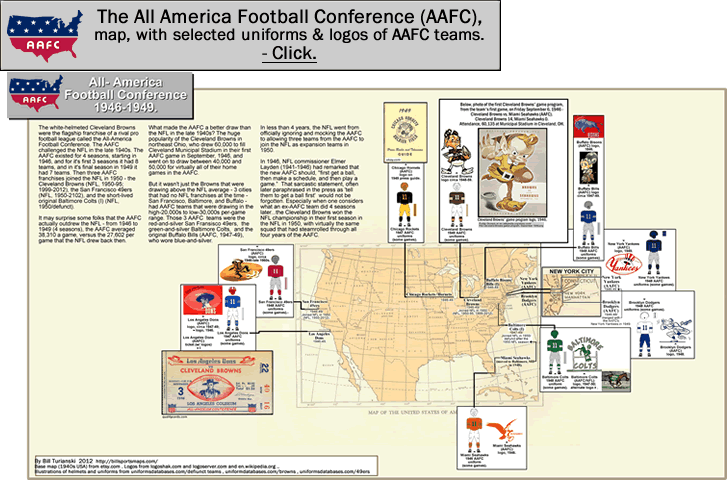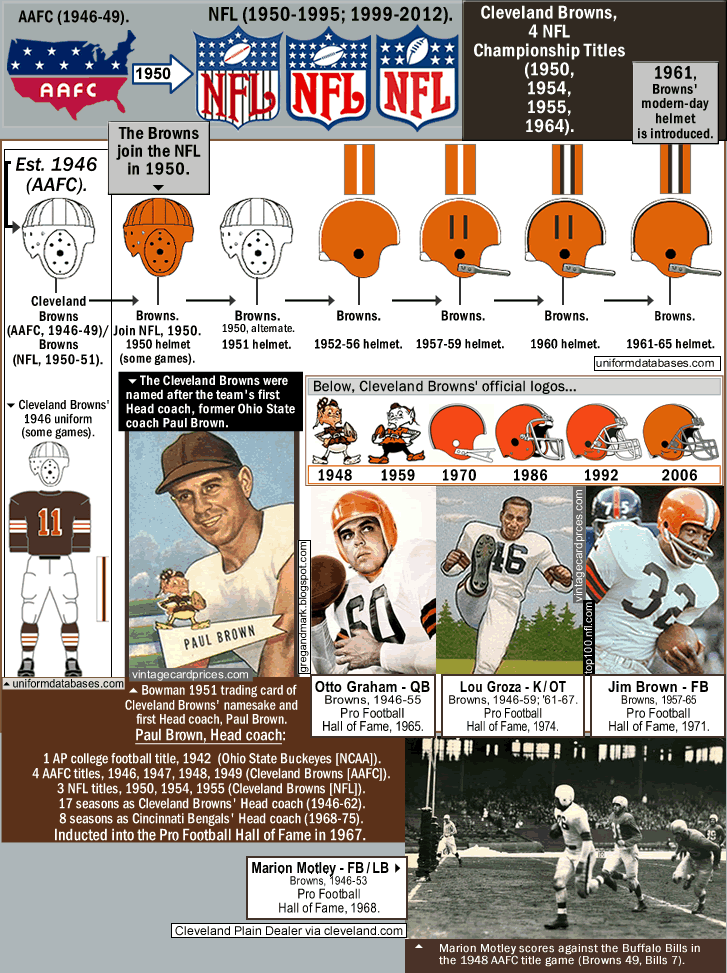Please note – All helmet and uniforms illustrations on the map, and in the charts, and in the illustrations here, are from The Gridiron Uniform Database site, and were used by billsportsmaps.com here with permission from gridiron-uniforms.com.
…
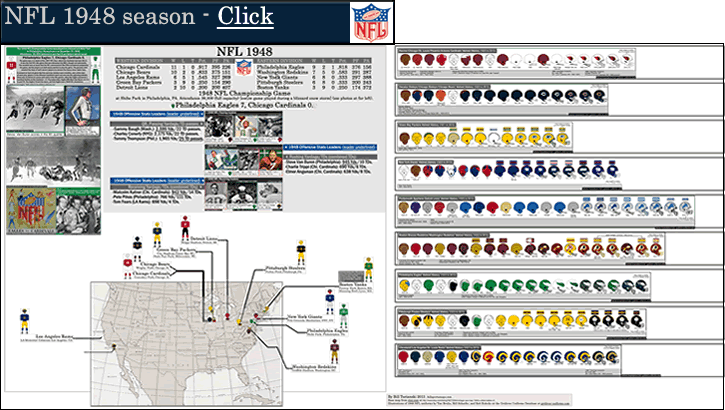
NFL, 1948 season, with offensive stats leaders & helmet histories of the 9 oldest NFL teams (Cardinals, Bears, Packers, Giants, Lions, Redskins, Eagles, Steelers, and Rams)
NFL helmet and uniforms illustrations from Gridiron Uniform Database.
…
…
NFL, 1948 season
From Pro FootbalHall of Fame site, ‘NFL’s All-Decade Team of the 1940s‘ (profootballhof.com/history).
1948: the highest-scoring season in the NFL
There are 3 reasons why the 1948 NFL season stands out. The first reason is, even though it pre-dated the passing era, 1948 was actually the NFL season that had the highest scoring average – 23.6 points per team (per game). From coldhardfootballfacts.com, from July 10, 2010, by Kerry Byrne, ‘The Spirit of ’48: a mind-blowing statistical orgasm‘. However, a mitigating factor must be mentioned. There were a few really bad defensive teams in the NFL in 1948, and, for example, the Eagles (who went on to be the 1948 NFL champions, and who had the league’s third-best offense in 1948 at 31.3 points per game) scored their season-high of 45 points in 4 games that year, three of which were against the three worst defenses in 1948 – the Lions (33.9 points allowed per game), the Giants (32.3 points allowed per game), and the Boston Yanks (31.0 points allowed per game), [more on the hapless Boston Yanks further down in this post] {see this, pro-football-reference.com/years/1948}. But to just blame the points surge in 1948, and also in the high-scoring era of 1947-to-1967, on just some bad defensive teams would be a disservice to teams like the 1948 Chicago Cardinals (32.9 points per game), and the 1948 Chicago Bears (31.7 points per game), and the 1948 Philadelphia Eagles (31.3 points per game). These teams, as well as the 1948 Los Angeles Rams and the 1948 New York Giants, really did have some offensive punch and some real standouts in their squads (illustrations of 1948 offensive leaders are shown on the map page {click on image above} and also further below).
Below – the 20 highest scoring NFL seasons, as measured by average number of points scored per team
The chart below shows the 20 highest-scoring seasons in the NFL – not by total points (because that would skew the list to all the years recently when there have been the most number of teams [32 teams]), but by points per game (per team) average. Note how the list of the 20 highest-scoring seasons includes many of the recent seasons (the 4 most-recent NFL seasons), as well as many seasons from the 1940s (3 seasons), and from the 1950s (5 seasons), and the 1960s (4 seasons) – but zero seasons from the 1920s or the 1930s or the 1970s. In fact, if you go to the link at the bottom of the chart – to the page at Pro-football-reference.com where I got the data, you will see that the 17 lowest-scoring seasons in the NFL were all from the 1920s and the 1930s, and that the highest-scoring season from the 1970s was only the 44th-highest scoring year in the NFL (in 1975) [please note, to get the list at Pro-football-reference.com to show highest-scoring-average by season, click on the word 'Pts' at the top of the column at the far right-hand side of the chart there].
Please note: chart below will be updated once more, after all the final regular season games are played (ie, after Dec. 29, 2013).
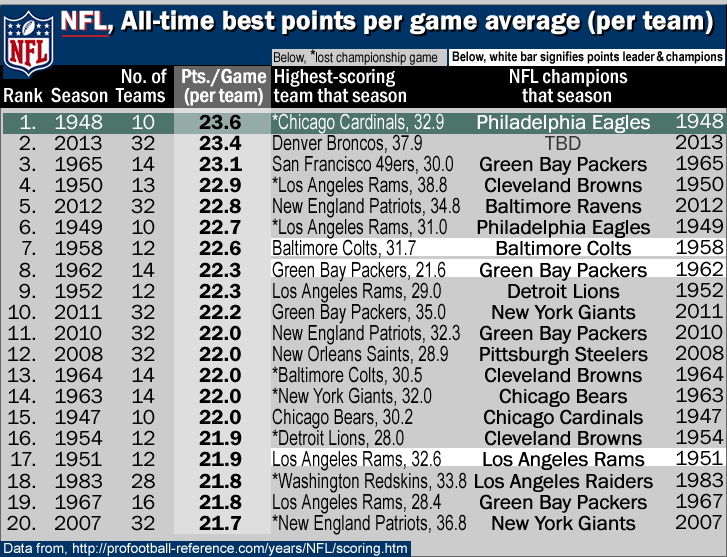
Data for chart above from: http://www.pro-football-reference.com/years/NFL/scoring.htm.
You might be thinking…’the scoring record in the NFL had to have been broken in the last couple years.’ And you would be pretty close to being right, because 2012 was the fifth highest points-per-game average in the NFL, and 2013 was the second highest. The NFL averaged 23.4 points per game (per team) in 2013, which was 0.2 points per game less than the NFL record still standing from the 1948 season.
The recent points-per-game numbers in the last several seasons of the NFL (2007 to 2013 NFL season) is a continuation of a trend towards more points-scored in the NFL…2007 was the 20th-highest (at 21.7 pts. per game), then 2008 was the 12th highest ever (at 22.0), then 2009 saw a momentary dip at 25th-highest ever (at 21.5), then 2010 was the 11th-highest ever at (22.0), then 2011 was the 10th-highest ever (at 22.2), and then last year [2012] was the 5th-highest ever (at 22.8), and now 2013 was the 2nd-highest ever (at 23.4). So it is really starting to look like it is only a matter of time before the team average scoring record set in 1948 is broken.
In case you are wondering, the NFL record for most points per game by one team was set two seasons after 1948 by the 1950 Los Angeles Rams, at a staggering 38.8 points per game {‘1950 Los Angeles Rams‘ (pro-football-reference.com)}. But like the situation two years previous [as mentioned in the first paragraph], the 1950 Rams played several games against very poor defenses- 3 of their 12 games in 1950 were against two of the worst defenses ever in the NFL, 2 games versus the 1950 Green Bay Packers, who gave up 406 points (or 33.8 points allowed per game); and one game versus the soon-to-be-defunct 1950 Baltimore Colts [the green-and-silver former-AAFC Baltimore Colts, who folded after one season in the NFL], who gave up 462 points (for a sieve-like 38.5 points allowed per game), went 1-11 and folded. Those green-and-silver Baltimore Colts of 1950 lost to the Los Angeles Rams by a score of 70-27 that season at Memorial Coliseum in LA. Those 70 points the LA Rams scored on October 22, 1950, as well as the 65 points the Rams scored one week later against the Detroit Lions, will always make it very hard for a modern-day NFL team to break the single season average scoring record, especially when you consider that teams in 1950 were playing one-quarter less games – 12 games instead of the present-day 16 games per season – so that 70 points and those 65 points factors in larger. {The 1950 boxscore for that Rams 70, Colts 27 score, plus a photo below the boxscore link (a photo of of Rams’ QB Bob Waterfield running for a TD as the Colts defenders are literally giving up the chase), can be seen in my post on the Cleveland/Los Angeles/St. Louis Rams, here, scroll down the page half-way to the 9th paragraph there.}.
{see this, by Joe Dorish at Yahoo contributor network from Oct. 4 2013, ‘Highest Scoring Teams with Best Offenses in NFL History [top 5]‘ (voices.yahoo.com).
Below,
Illustration of the All-time highest scoring teams (1920 to 2013, regular season/points per game) -
#1: 1950 Los Angeles Rams, #2: 2013 Denver Broncos, #3: 2007 New England Patriots, #4: 1961 Houston Oilers (AFL), #5: 1941 Chicago Bears.
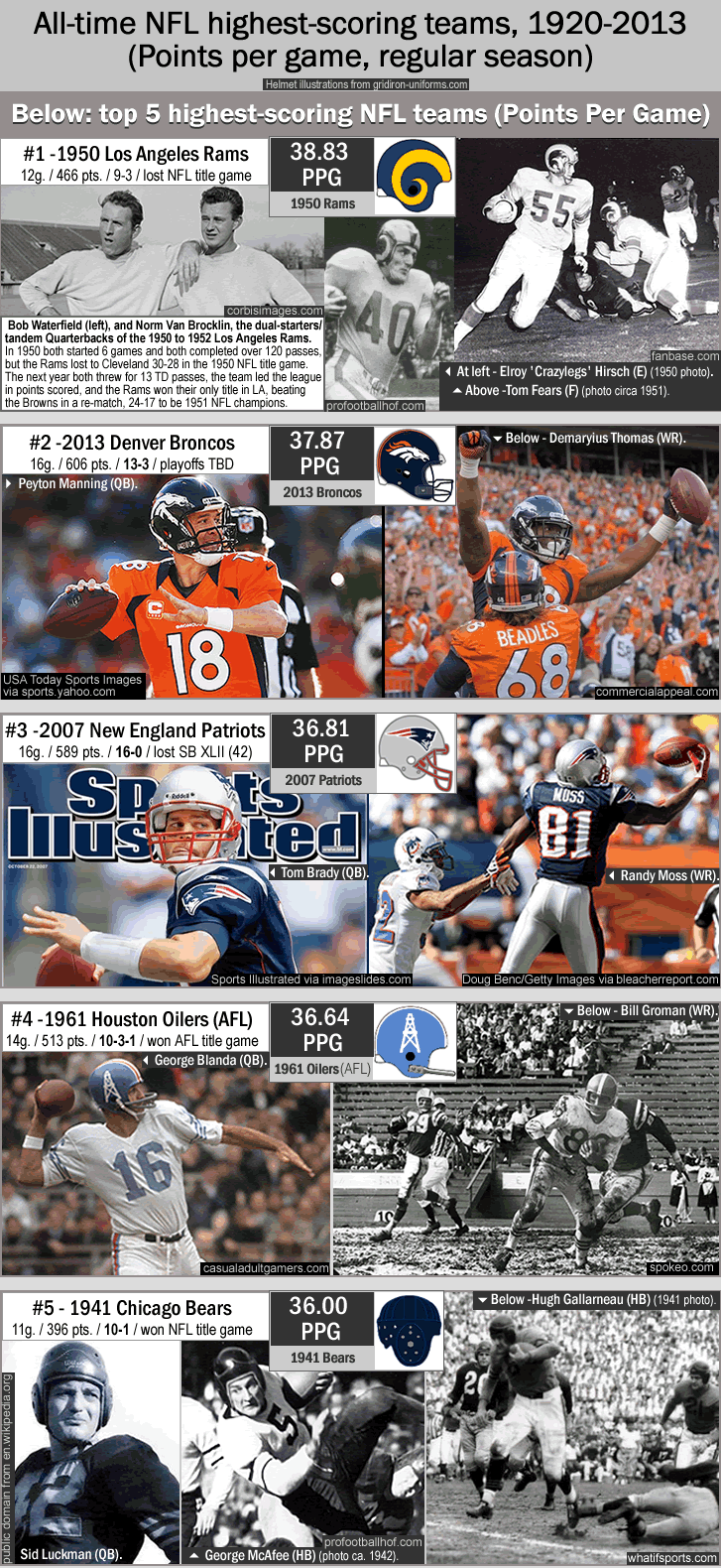
Photo and Image credits above –
Helmet illustrations,
helmet illustrations from The Gridiron Uniforms Database.
1950 Rams,
Bob Waterfield and Norm Van Brocklin photo, from Corbis at corbisimages.com/stock-photo/bob-waterfield-and-norm-van-brocklin-standing.
Crazy Legs Hirsch, action photo from profootballhof.com/fact-or-fiction-hall-of-famer-elroy-hirsch-was-nearly-stripped-naked-by-fans-after-a-game.
Tom Fears, action photo from fanbase.com/Tom-Fears/photo.
2013 Broncos,
Peyton Manning, photo from USA Today Sports Images sports.yahoo.com/blogs.
Demaryius Thomas, photo unattributed at commercialappeal.com.
2007 Patriots,
Tom Brady. photo from Sports Illustrated via imageslides.com/Sports/gallery/4345-Past-10-NFL-MVP-Winners#9 .
Randy Moss, photo by Doug Benc/Getty Images via bleacherreport.com/articles/722541-dallas-cowboys-all-time-biggest-draft-misses.
1961 Houston Oliers (AFL),
George Blanda, photo from casualadultgamers.com/thread-All-Time-Teams.
Bill Groman, photo from spokeo.com.
1940 Chicago Bears,
Sid Luckman, photo public domain from en.wikipedia.org.
George McAfee, photo from profootballhof.com/Bears-vs-Packers-in-1941-NFL-Playoff-Game.
Hugh Gallarneau, photo from whatifsports.com/article_1941BearsPackers.
…
In 2013 the team average scoring record had a chance of being broken as well, by the 2013 Denver Broncos. The Broncos under Manning finished 13-3 and averaged 37.9 points per game. (Note: also in 2013, Peyton Manning broke the NFL record for TD passes, with 55 TD passes). The Broncos’ 37.9 points per game was 0.9 points per game less than the NFL record set by the 1950 Rams. The Rams of that era had an unusual [read: totally unheard of and unprecedented in NFL history] tandem-QB arrangement of Bob Waterfield and Norm Van Brocklin – both played all 12 games and both had over 120 completions. But don’t forget, those 1950 Rams played against two of the worst defenses ever, while the worst defenses Manning and the Broncos have faced were the 4-12 Oakland Raiders, who averaged 28.3 points allowed per game (453 points allowed), the 4-12 Jacksonville Jaguars, who averaged 28.0 points allowed per game (449 points allowed), and the 2-14 Houston Texans, who averaged 26.7 points allowed per game (428 points allowed). That is not as bad as the 1950 Packers defense (about 6-to-8 points-allowed-per-game worse) or the hapless 1950 Colts (I) defense (about 10-to-12 points-allowed-per-game worse). So to be simplistic about it, the 1950 Rams, as potent as their Bob Waterfield/Norm Van Brocklin-led offense was, still ended up having a bit more “inflated” offensive stats by virtue of the cumulatively worse defenses they faced.
The Broncos didn’t break the Rams’ 1950 NFL record for most points scored per game, but the Broncos broke the NFL record for most points scored by a team in a season, with 606 points. That record had been held by the 2007 New England Patriots, who scored 589 points that season, but then ended up losing to the New York Giants in the Super Bowl that season. Which brings up an important point – the highest-scoring team in the NFL does not usually win the NFL title that season. As the list below shows, the highest-scoring team in a season has won the NFL title in only 26 of the 93 seasons so far (27.9 percent of the time).
Below, NFL, all-time list of seasons that the league’s top scoring team won the title [since 1920], (with the team’s points per game average listed)
1923, Canton Bulldogs (20.5).
1926 Frankford Yellow Jackets (13.6).
1931 Green Bay Packers (20.7).
1932 Chicago Bears (11.4).
1936 Green Bay Packers (20.6).
1941 Chicago Bears (36.0).
1943 Chicago Bears (30.3).
1946 Chicago Bears (26.2).
1949 Philadelphia Eagles (36.4).
1951 Los Angeles Rams (32.6).
1955 Cleveland Browns (29.0).
1958 Baltimore Colts (31.7).
1959 Baltimore Colts (31.6).
1961 Green Bay Packers (27.9) / 1961 AFL champions, Houston Oliers (36.6).
1962 Green Bay Packers (29.6) / 1962 AFL champions, Dallas Texans (27.8).
/ 1963 AFL champions, San Diego Chargers (28.5).
/ 1964 AFL champions, Buffalo Bills (28.6).
/ 1966 AFL champions, Kansas City Chiefs (32.0).
/ 1967 AFL champions, Oakland Raiders (33.4).
1969 Minnesota Vikings [NFL champions but lost Super Bowl IV to the AFL's Kansas City Chiefs] (27.1).
1971 Dallas Cowboys (29.0).
1972 Miami Dolphins (27.5).
1979 Pittsburgh Steelers (26.0).
1989 San Francisco 49ers (27.6).
1991 Washington Redskins (30.3).
1994 San Francisco 49ers (31.6).
1996 Green Bay Packers (28.5).
1997 Denver Broncos (29.5).
1999 St. Louis Rams (32.9).
2009 New Orleans Saints (31.9).
One note – in the list above I included the Vikings’ meaningless 1969 NFL championship title (it is meaningless because, like the Colts’ 1968 NFL championship title, both of those NFL teams went on to lose the Super Bowl that season to AFL teams [Jets and Chiefs]). For the purposes of this exercise, I had to include that, though, and I also felt it necessary to include the AFL seasons (see four sentences below). So there have been 26 NFL titles won by the top-scoring team that year – in 93 NFL seasons (2013 is the 94th NFL season). That means that only 27.9 percent of the time, the top scoring team in the NFL has gone on to be the champions that season. Which only goes to prove, once again, the old adage that Defense wins titles. The wild-and-woolly and high-scoring AFL is an entirely different matter though, seeing as how in 60% of the seasons the AFL played (6 out of 10 seasons), the highest scoring team in their league that year won the AFL title.
…
1948 NFL offense leaders (passing, rushing & receiving, with TD leaders noted)
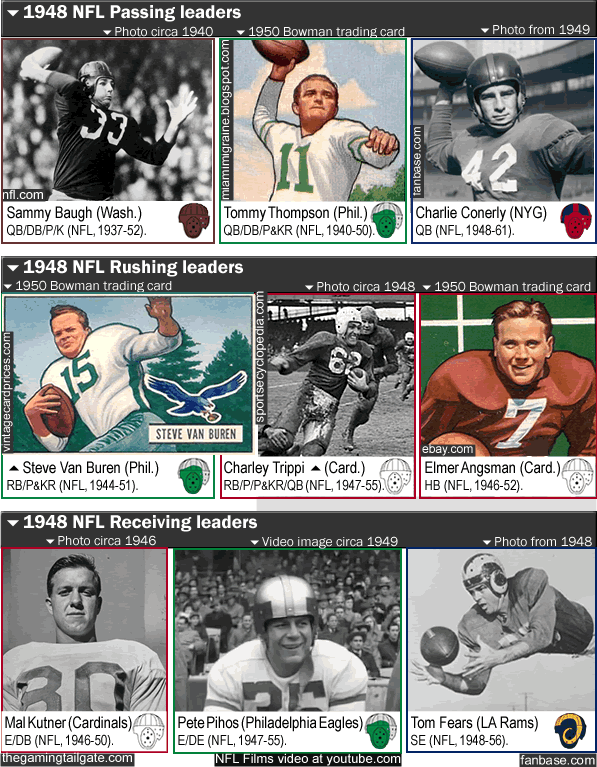
1948 NFL offensive leaders [Note: 1948 NFL was a 12-game season.]
NFL Passing Yardage/TD passes:
-Sammy Baugh (Washington Redskins): 2,599 Yds/22 TD passes (plus 1 rushing TD).
-Charlie Conerly (New York Giants): 2,175 Yds/22 TD passes (plus 5 rushing TDs).
-Tommy Thompson (Philadelphia Eagles): 1,965 Yds/25 TD passes (plus 1 rushing TD) (TD pass leader for 1948, with 25 TD passes).
1948 NFL Rushing Yardage/combined TDs:
-Steve Van Buren (Philadelphia Eagles): 945 Yds/10 TDs (rushing TD leader for 1948, with 10 rushing TDs).
-Charley Trippi (Chicago Cardinals): 690 Yds/10 TDs (6 rushing TDs and 2 receiving TDs and 2 punt-return TDs).
-Elmer Angsman (Chicago Cardinals): 638 Yds/9 TDs (8 rushing TDs and 1 receiving TD).
1948 NFL Receiving Yardage/combined TDs:
-Malcolm Kutner (Chicago Cardinals): 943 Yds/14 TDs (recieving TD leader for 1948 plus overall TDs-scored leader for 1948, with 15 TDs [14 receiving TDs & 1 rushing TD]).
-Pete Pihos (Philadelphia Eagles): 766 Yds/11 TDs.
-Tom Fears (Los Angeles Rams): 698 Yds/4 TDs.
Photo and Image credits above & on the map page -
Sammy Baugh, nfl.com/75th Anniversary Team.
Tommy Thompson, [1950 Bowman trading card], miamimigraine.blogspot.com/2010/06/tommy-thompson.
Charlie Conerly, fanbase.com/photo.
Steve Van Buren, [1950 Bowman trading card], vintagecardprices.com/card-profile/154925/1951-Bowman-Steve-Van-Buren.
Charlie Trippi , sportsecyclopedia.com/nfl/azchi/cardschipictures.
Elmer Angsman , ebay.com/elmer+angsman.
Mal Kutner, thegamingtailgate.com/forums/showthread.php?1980-NCAA-Football-12-Countdown-Thread.
Pete Pihos, screenshot of an NFL Films video at youtube.com via fifthdown.blogs.nytimes.com/2011/08/17/remembering-pete-pihos-pioneering-tight-end.
Tom Fears, fanbase.com/Tom-Fears/photo.
Illustrations of helmets from Gridiron Uniforms Database.
…
The second reason the 1948 NFL season it noteworthy is because it had the first-ever appearance of a logo on a football helmet
The first helmet logo in the NFL was the famous golden Rams horns worn by the 1948 Los Angeles Rams (and are worn to this day by the franchise [since 1995 known as the St. Louis Rams]). The Rams’-horn logo was created by LA Rams halfback and defensive back and off-season commercial artist Fred Gehrke. Here is an excerpt from the ‘Fred Gehrke‘ page at en.wikipedia.org…
{excerpt}…’In the mid-1940s Gehrke toyed with the notion of painting a football helmet. Rams coach, Bob Snyder suggested that Fred paint a helmet with the ram horns on it that he could present to the team’s owner Dan Reeves. Fred painted two ram horns on an old college helmet and presented the design to Reeves, who was intrigued by the design. Reeves then contacted the NFL for a ruling on legality of having a football helmet painted. It was reported that the answer Reeves received from NFL was “You’re the owner; do what you want!” Reeves then tasked Gehrke to paint 75 helmets at $1.00 per helmet. The project took Gehrke the entire summer of 1948. The newly painted helmets debuted during a pre-season match-up between the Rams and Redskins at the Los Angeles Coliseum before a crowd of [77,000]. Upon seeing the new helmets the crowd began cheering which was followed by a five-minute standing ovation. To this day, Gehrke’s rams horn logo is still worn by the team.’…{end of except}.
Here is a good article on Gehrke and his designing of the Rams helmet logo, from Sports Illustrated, from Sept. 5 1994, by Mark Mandemach, ‘Rembrandt Of The Rams
Fred Gehrke got out his brushes and changed helmets forever‘ (sportsillustrated.cnn.com/vault).

Photo and Image credits above -
helmethut.com/leatherram.
toddradom.com/athletes-as-artists-andrew-mccutchen-and-the-1948-la-rams.
gridiron-uniforms.com/1948.
profootballhof.com/history/infographic-wednesday.
…
Before I get to the 3rd way in which the 1948 NFL season stands out from all the rest, I’ll add a fourth reason, an asterisk if you will. 1948 was the last season that the bizarrely-named Boston Yanks played in the NFL. It is kind of hard to believe, but there actually was once a professional sports team from Boston that was called the Yanks. Their owner was a New York City-based talent agent named Ted Collins (he managed the popular singing star Kate Smith). Collins didn’t really want an NFL franchise located in Boston – he wanted to locate the franchise at Yankee Stadium in The Bronx, NY (his NFL team finally got to Yankee Stadium 6 years later, but not for long). The Boston Yanks (NFL, 1944-48) wore green and yellow {here are the Boston Yanks’ ghastly 1946 NFL uniforms (gridiron-uniforms.com/defunct teams). The Boston Yanks played from 1944–1948 to a lopsided losing record of 14-38-3, and to vast public indifference – when most every other NFL team was drawing 20,000 to 30,000 per game back then, the Boston Yanks were often drawing below 10,000 at Fenway Park. But you really could not blame Boston sports fans for not supporting the Boston Yanks – supporting a team in Boston named after the much-hated New York Yankees would be tantamount to treason.
After the 1948 season the Boston Yanks were folded and for a tax write-off the NFL allowed Collins to have a “new” franchise, which he moved to New York City, to become the New York Bulldogs (NFL, 1949), who played some home games in ’49 at the Polo Grounds in northern Manhattan, NYC, NY, and the 1949 New York Bulldogs also played a couple games in Boston. For some reason, the 1949 New York Bulldogs wore sky-blue-and-silver, which made them look more like lap dogs. In 1950, Collins was finally able to get his team to play in Yankee Stadium in The Bronx, NYC, NY, so he (finally) changed the team’s name to the New York Yanks (NFL, 1950-51), but in NYC, the franchise never had a shot at success because they were very bad in 2 of their 3 years in NY (going 1-10-1 in 1949, 7-5 in 1950, and 1-11-1 in 1951), and they had to compete with the vast popularity of the New York Giants’ NFL team.
In 1950, in their second year in New York City and their first year as the Yanks, the team wore sky-blue-and-white (why?) {1950 New York Yanks NFL uniforms}. In the third and last year of the franchise, 1951, the New York Yanks wore the more Yankees-appropriate dark-blue-and-grey {1951 New York Yanks NFL uniforms}. Those uniforms are actually kind of nice. They would be pretty much the same uniforms that the 1952/soon-to-be-defunct-Dallas Texans NFL team wore (see 2 sentences below). But it was too late – the New York Yanks’ debts had piled up and Ted Collins threw in the towel, and the NFL ‘bought back’ (read: took over) the worthless franchise, and folded it. The 12 players who remained on the 1951 New York Yanks’ roster (including future Hall of Famers Art Donovan and Gino Marchetti) were assigned to another soon-to-be-defunct-new-NFL-franchise, the short-lived Dallas Texans of 1952 (who wore almost the exact same uniforms as the 1951 NY Yanks – {1952 Dallas Texans NFL uniforms}). The NFL had to step in again and take over the 1952 Texans (who ended up 1-11 and never drew higher than 17,000 in their 4 home games in Dallas), and once again the remaining 12 players still on the defunct team’s roster (including, once again, future Hall of Famers Art Donovan and Gino Marchetti) were assigned to a new franchise for 1953 – the Baltimore Colts (II) (present-day Indianapolis Colts). That Dallas Texans team of 1952, which had its roots in the failed Boston Yanks/New York Bulldogs/New York Yanks team – that was the last failed franchise in the NFL. Here is a great little article about the Boston Yanks, from April 2009, by Jay Schreiber, from the, er, baseball blog at NYTimes.com, ‘Remembering a Team of Rivals‘ (bats.blogs.nytimes.com).
…
Brief summary of the 1948 NFL season
‘1948 NFL season‘ (en.wikipedia.org).
[Note, during this season and during the 1946 to 1949 time period, the NFL was fending off a challenge from a rival pro football league, the All-America Football Conference (the AAFC). For more info on that, you can see my recent post on the Cleveland Browns and the AAFC by clicking on the following, 'AAFC (1946-49) featuring the Cleveland Browns - map with selected uniforms and logos of the teams: Baltimore Colts (I), Brooklyn football Dodgers [AAFC], Buffalo Bisons/Bills (I), Chicago Rockets/Hornets, Cleveland Browns, Los Angeles Dons, Miami Seahawks, New York football Yankees [AAFC], San Francisco 49ers‘.]
There were 10 teams in the 1948 NFL, and for the second season, teams were playing a 12-game schedule as opposed to the 11-game schedule which the league had from 1937 to 1946. All teams played home-and-away games versus all the other teams in their division (8 games), and they played 4 of the 5 teams in the other division. All the NFL teams (that is to say, all the NFL franchises) from 1948 still exist, except for the previously-mentioned Boston Yanks (the ones that still exist being the Cardinals, Bears, Packers, Giants, Lions, Redskins, Eagles, Steelers, and Rams). This was the last season that players were only allowed to use leather helmets, because, while the new plastic-composite helmets were available and some colleges had started using them, they were banned in 1948 in the NFL because it was felt by the league officials that the much harder plastic helmets were being used more as a weapon than as protection (hmm, that sounds like what some critics say to this day).
Winner of each division would advance to the NFL Championship Game, which was played back then not at the home of the team with the better record, but rather, hosted on a rotating basis between the two divisions. As the Western Division had hosted the previous title game in 1947 (won by the Chicago Cardinals over the Philadelphia Eagles at Comiskey Park (I), by a score of 28-21), in 1948 it was the Eastern Division’s turn to host the title game.
1948 Eastern Division
In the Eastern Division, in the 5th week, the Philadelphia Eagles took a half-game lead on the Washington Redskins after beating them. 5 weeks later, the Eagles took the lead for good with their second win over Washington, putting the Eagles at 7-1-1 and Washington at 6-3. The Eagles finished 9-2-1, and advanced to their second title game in a row (and their second playoff game ever in their 16-year history). The Redskins had won 2 NFL titles at this point in time (their first title coming in 1937 in their first season in Washington DC [following 6 seasons in Boston]; and their second title in 1942). The Redskins were about to enter a long period of futility, with only 3 winning seasons in the next 21 years (up to 1969). As for the New York football Giants, well the Giants were in the midst of a several-seasons slump and, having won their first NFL title in their 3rd year in 1927, and after having won two more titles in a 5-year span (in 1934 and in 1938), the Giants would win only one more title in the pre-Super Bowl era in the NFL (ie, pre-1966 season), in 1956 (though the Giants came close many times otherwise). The Steelers were also in the East then, but the perpetually cash-strapped Steelers were the worst-team-ever in the NFL back then (and were the worst-ever up to the AFL/NFL merger in 1970). Of course, after that, the Steelers became the dynasty they are today, but 65 years ago, the Steelers were also known as the Lovable Losers.
1948 Western Division
In the Western Division, although the Los Angeles Rams were competitive and would finish at 6-5-1 in 3rd place (and would make it to the NFL title game for the next 3 seasons and then win their only NFL title in LA 3 years later in 1951), for all intents and purposes, the 1948 West was really all about the two Chicago teams. The Windy City was the only city in the NFL back then that boasted two NFL teams – the Monsters of the Midway (the Bears) and the perpetually overshadowed Cardinals (who would move to St. Louis 11 years later). The Chicago Bears were the most successful team in the NFL at this point in time, with 7 titles including the 1946 championship (Green Bay had the second-most titles then, with 5, but the cash-strapped Packers were, at this point, about to begin their worst run, with 12 straight seasons without a winning record [and would not have a resurgence until coach Vince Lombardi came to Green Bay starting in 1959]). To round out the NFL teams of this era, the Detroit Lions were horrible in 1948, but were on the cusp of their greatest period ever. The Lions had begun life as the second-to-last small-town team in the NFL – the Portsmouth (Ohio) Spartans, who played 4 seasons in the NFL (1930-33) and finished in 2nd place twice. The franchise moved to Detroit, Michigan in 1934, changed their name to the Detroit Lions, and won their first title the following year in 1935. After 1948, the Lions began rebuilding and would go on to win titles in back-to-back seasons in 1952 and 1953, and win their fourth and last NFL title four years later in 1957.
For the two seasons of 1947 and 1948, the normal Bears/Cardinals dynamic was up-ended. Following massive player-spending prior to the 1947 season, the Cardinals, led by future-Hall of Fame running back Charley Trippi, were temporarily the dominant of the two (of course it didn’t last, and the Cardinals have never won a title since 1947). Here is an excerpt from the 1948 NFL page at Wikipedia (linked to above),
…{excerpt}…’[T]he Cardinals and Bears both had records of 10–1 going into the final week. A record crowd of 51,283 packed Wrigley Field on December 12 to watch. The Bears took a 21–10 lead, on George Gulyanics’ [touchdown run] as the fourth quarter began. Charley Trippi’s touchdown cut the margin to 21–17, but the Bears had the ball and time on their side. The turning point came when the Cards’ Vince Banonis picked off a pass from Johnny Lujack, and ran the ball back to the Bears’ 19, and [Cardinals' running back] Elmer Angsman scored the winning touchdown three plays later for the Western Division title and the trip to the championship.’…{end of excerpt}.
For the second-straight year, the usually-downtrodden Cardinals had beaten out the usually-dominant Bears for the divisional title. Some say that that 24-20 loss to the Cards in the last week of the 1948 season was one of the worst losses the Bears ever suffered. The gentleman who wrote the following article says it was the worst ever loss for the Bears. From ChicagoNow.com, from Dec. 13 2011, by Captain Meatball, ‘Top 10 Toughest Losses in Chicago Bears History [#1. Chicago Cardinals 24, Chicago Bears 21, 1948]‘ (chicagonow.com).
…
1948 NFL Championship Game
The final reason why the 1948 NFL season stands out is the title game that year
The 1948 NFL Championship Game, featuring the Philadelphia Eagles versus the Chicago Cardinals, was played in a full-scale blizzard in Philadelphia that almost was postponed. It is testament to the hardiness of the Philadelphia sports fan that the inclement weather did not depress turnout – the game drew a sell-out crowd of 36,000. I guess it wasn’t technically a sell-out, because admission was free if you helped shovel snow.
1948 NFL Championship Game – Philadelphia Eagles 7, Chicago Cardinals 0.
The 1948 NFL Championship Game was played in a blizzard at Shibe Park in Philadelphia, Pennsylvania on December 19, 1948. Attendance was a full-capacity 36,309. The game was a re-match of the 1947 NFL final, which the Cardinals had won 28-21 at Comiskey Park (I) in Chicago, Illinois the previous December.
The 1948 NFL title game was the first NFL title game that was televised (by ABC), though it was not broadcast nationwide (the first nationwide television broadcast of an NFL title game was by NBC in 1958). The snowfall that day in Philadelphia was so heavy that the NFL commissioner Bert Bell considered postponing the game, but because broadcast rights had already been given to ABC and because the players on both teams wanted to play despite the snow storm, Bell decided to play the game. (It is very doubtful the game would have been played were it to happen today – and with the NFL now playing a Super Bowl this season in a cold-weather location in northern New Jersey in February 2014, this possibility of a snow-storm-during-an NFL-title-game suddenly now exists again.).
From youtube.com, ‘Football Championship Game 1948 Eagles Cardinals‘, a 1:15 video uploaded by historycomestolife [no sound] (youtube.com). [Note: that long pass play by the Eagles, shown in the video, was called back because of an offensive penalty...the reason why it was still featured in the newsreel of the game is that the snowy conditions prevented there being many significant offensive plays that day]. [Note: here is a much longer Youtube video of the 1948 title game, with sound, a 15:41 video uploaded by Caladiscafrosis, '1948 NFL Championship Game'].
The start of the 1948 title game was delayed 30 minutes, as the grounds crew needed the help of both teams’ players to remove the extremely heavy, snow-laden tarp. It snowed so hard all game that the yard-line markers were invisible, and the referee had to basically guess where the ball was to be placed after each down and where the first down line was. The snowfall was so heavy that, at the start of each play, players in the offensive backfield could not even see the opposing defensive backs 15 or 20 feet away. {Here is a classic photo of the freezing Eagles players on the bench that day [in that photo you can see the odd-shaped MacGregor leather helmets that the Eagles wore during the 1944 to '48 time period, which featured a more elongated, quasi-cone-head shape and a different set of seams than the more standard Rawlings leather helmets that most other NFL teams used in the early post-War era] (photo unattributed at goldenrankings.com/[NFL Championship Game 1948]).}
Because of the white-out/blizzard conditions, both teams spent the bulk of their ball possession in three-and-outs and a punt. There was no threat of a score until early in the 4th quarter, when the Eagles recovered a Cardinal fumble on the Cardinals’ 17. Four plays later, Eagles RB Steve Van Buren ran in a 5-yard TD. The Eagles’ defense then held the score, and the Eagles were the 1948 NFL champions.
The Eagles would repeat as champions in 1949, beating the Los Angeles Rams 14-0 in muddy conditions at the Los Angeles Memorial Coliseum, with Steve Van Buren rushing for a then-title-game record 197 yards, as well as scoring both TDs. Steve Van Buren played 9 seasons for Philadelphia, and was a 7-time All-Pro, and was the first RB to gain 1,000 yards in a season twice (in 1947 and ’49). Van Buren was elected to the Pro Football Hall of Fame in 1965. He passed away at the age of 91 in 2012.
From the New York Times, from Aug. 25, 2012, by Andy Barall, ‘Remembering Steve Van Buren, Hall of Famer for Eagles‘ (fifthdown.blogs.nytimes.com).
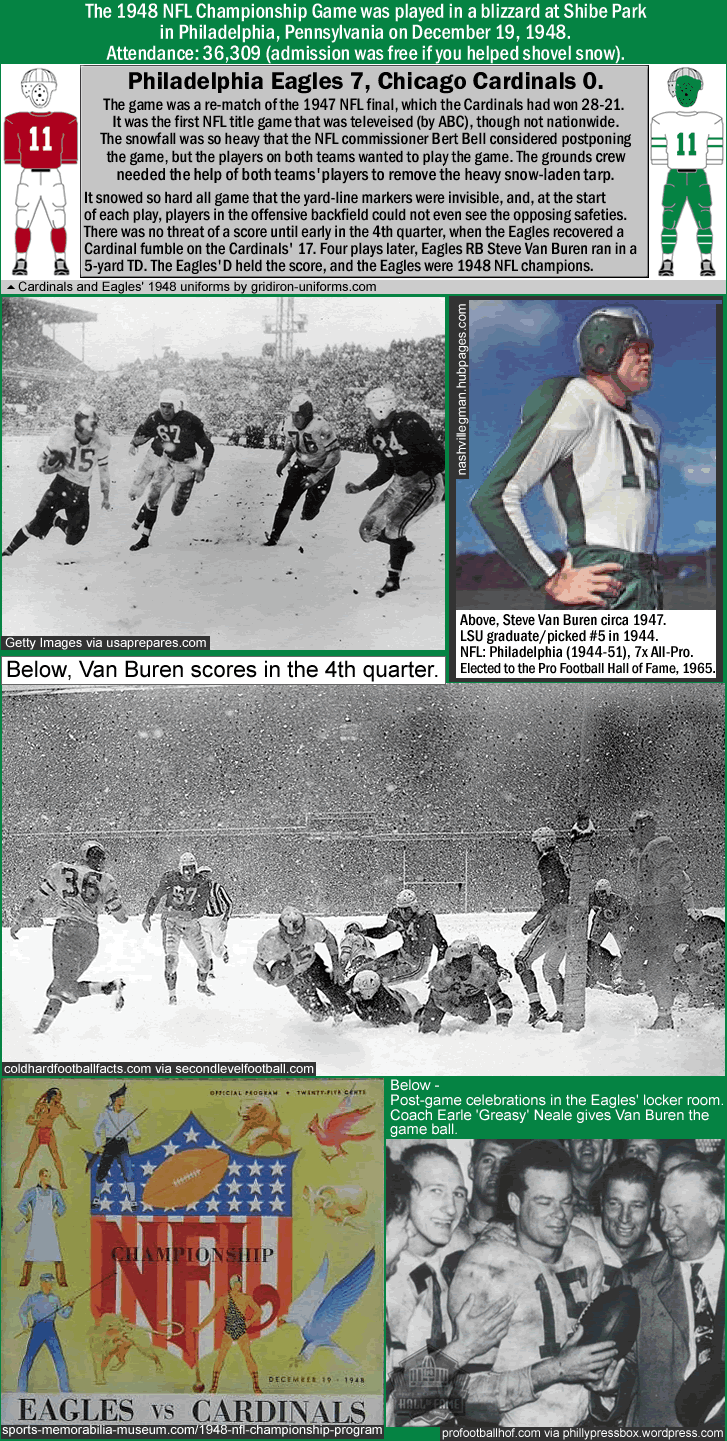
Photo and Image credits above -
Illustrations of Cardinals and Eagles’ 1948 uniforms from gridiron-uniforms.com/1948.
Photo of Steve Van Buren being pursued by Cardinals defenders from Getty Images via usaprepares.com/survival/winter-is-going-to-be-much-colder-than-normal-and-therell-be-a-big-storm-for-super-bowl-predicts-farmers-almanac.
Color photo of Steve Van Burennashvillegman.hubpages.com/hub/Philadelphia-Eagles-All-Time-Rushing-Yardage-Leaders
Photo of Steve Van Buren scoring winning TD from Cold Hard Football Facts.com site via secondlevelfootball.com/2012/08/24/steve-van-buren-1920-2012.
Photo of Eagles’ post-game celebrations from profootballhof.com via phillypressbox.wordpress.com/2012/08/26/steve-van-buren-the-eagles-legend.
Photo of 1948 NFL title game program from sports-memorabilia-museum.com/football-history/1948-nfl-championship-program.
___
Thanks to Etsy.com/ Vintage Inclinations, for the base map of United States circa 1940s, http://www.etsy.com/listing/99272564/vintage-usa-map-1940s-united-states-of.
Thanks to the contributors at en.wikipedia.org, ‘1948 NFL season‘.
A big thanks to Pro-Football-Reference.com, for most of the stats used in this post.
Special thanks to Tim Brulia, Bill Schaefer and Rob Holecko of The Gridiron Uniform Database, for giving billsportsmaps.com the permission to use the football uniforms illustrations at http://www.gridiron-uniforms.com/.

